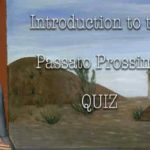Exploring the Passato Remoto in Italian: A Journey into the Past
Il Passato Remoto è un tempo passato italiano del modo indicativo.
The Passato Remoto is an Italian past tense of the modo indicativo.
Il Passato Remoto (io mangiai, “mangiai” in un passato lontano) indica un evento considerato al di fuori della sua durata e concluso nel passato, senza collegamenti con il presente.
The Passato Remoto (io mangiai, “I ate” in a distant past) indicates an event considered outside of its duration and concluded in the past, with no connections to the present.
Le discussioni ruotano attorno al Passato Remoto e alla sua classificazione come “specie linguistica in via di estinzione.” Negli ultimi decenni, la prevalenza di questo tempo nell’italiano parlato e scritto è diminuita. Il passaggio verso un italiano meno formale e complesso, specialmente nell’Italia del Nord, ha contribuito al suo declino.
Discussions revolve around the Passato Remoto and its classification as a linguistic “endangered species.” In recent decades, the prevalence of this tense in spoken and written Italian has diminished. The shift towards less formal and intricate Italian, especially in Northern Italy, has played a role in its decline.
Il Passato Prossimo si fa avanti con immediatezza, rendendolo uno strumento linguistico preferito della televisione e di altri media. I domini della parola parlata e scritta — social media, notizie, film, radio — favoriscono questo tempo. I giornali, sintonizzati sugli eventi contemporanei, relegano il Passato Remoto agli archivi e alla narrativa.
The Passato Prossimo steps forward with immediacy, making it a preferred linguistic tool of television and other media. The realms of spoken and written word — social media, news, movies, radio — favor this tense. Newspapers, tuned to contemporary events, relegate the Passato Remoto to the archives and narrative.
Tuttavia, il Passato Remoto prospera nell’uso letterario. I romanzi costruiti con questo tempo fioriscono in narrazioni dettagliate.
Yet, the Passato Remoto thrives in literary usage. Novels crafted with this tense flourish in detailed narratives.
Per me, l’eleganza del Passato Remoto è innegabile. Tuttavia, come italiano del Nord, confesso di aver vissuto comodamente senza di esso per la maggior parte della mia vita adulta.
For me, the elegance of the Passato Remoto is undeniable. However, as a Northern Italian, I confess to having lived comfortably without it for most of my adult life.
Le fondamenta dei dialetti italiani locali—su cui si basa l’italiano standard—mancano del Passato Remoto. Pertanto, gli italiani del Nord lo ignorano. Alcuni dialetti del Sud Italia, al contrario, lo abbracciano come loro tempo passato di scelta, nel dialogo quotidiano.
The foundations of local Italian dialects—on which standard Italian stands—lack the Passato Remoto. Thus, Northern Italians ignore it. Some Southern Italy’s dialects, in contrast, embrace it as their past tense of choice, in daily dialogue.
Occasionalmente, noi milanesi inciampiamo nel passato, sbagliando tempo quando usiamo il Passato Prossimo per azioni lontane:
Occasionally, we Milanese stumble in the past, misplacing the tense when using the Passato Prossimo for distant actions:
- Mio nonno
ha combattutola guerra. —> Mio nonno combatté la guerra.
Alcuni italiani del Sud, tuttavia, si muovono nella direzione opposta, impiegando il Passato Remoto in modo scorretto:
Some Southern Italians, however, move in the opposite direction, employing the Passato Remoto incorrectly:
- Ieri
andaial mercato. —> Ieri sono andato al mercato.
Entrambi sono deviazioni.
Both are deviations.
I toscani e gli italiani del Centro trovano un equilibrio nel loro uso, mentre le voci napoletane suggeriscono una dipendenza più leggera rispetto, per esempio, al bel italiano meridionale della Sicilia e della Calabria.
Tuscans and Central Italians strike a balance in their usage, while Neapolitan voices suggest a lighter reliance compared, for example, to the beautiful Southern Italian of Sicily and Calabria.
Mentre l’uso del passato remoto invece del passato prossimo è ancora fortemente regionale nel Sud, l’uso del passato prossimo al posto del passato remoto sta diventando sempre più diffuso, anche fuori dall’Italia del Nord e in registri linguistici più elevati.
While the use of the passato remoto instead of the passato prossimo is still strongly regional in the South, the use of the passato prossimo in place of the passato remoto is becoming increasingly widespread, even outside Northern Italy and in higher registers of language.
Tuttavia, sia nello scrivere che nel parlare, è sempre meglio utilizzare tutte le risorse che la lingua offre, e quindi sfruttare le varie sfumature fornite dal complesso intreccio dei tempi verbali.
However, both in writing and speaking, it is always better to make use of all the resources the language offers, and thus take advantage of the various nuances provided by the complex interplay of verb tenses.
Sebbene in declino, il Passato Remoto prospera tra le pagine dei libri. Una necessità di apprendimento? Sì. Studiatelo, apprezzate la sua bellezza e abbracciate il suo potere espressivo per comunicare eventi passati!
Although in decline, the Passato Remoto thrives within the pages of books. A learning necessity? Yes. Study it, appreciate its beauty, and embrace its expressive power for conveying past events!
Iniziamo dalle regole grammaticali di base.
Let’s start from the basic grammar rules.
Passato Remoto dei Verbi Regolari
| ballare | vendere | dormire | |
|---|---|---|---|
| io | ballai | vendei (vendetti) | dormii |
| tu | ballasti | vendesti | dormisti |
| lui / lei | ballò | vendé (vendette) | dormì |
| noi | ballammo | vendemmo | dormimmo |
| voi | ballaste | vendeste | dormiste |
| loro | ballarono | venderono ( vendettero) | dormirono |
Please notice how –ere regular verbs have two possible conjugations with the Passato Remoto. Both are correct.
Examples – Verbi Regolari
- Quando incontrai il direttore, non compresi subito la gravità della situazione.
When I met the director, I didn’t immediately understand the gravity of the situation. - L’ultima volta, molti anni fa, dimenticammo di fare le prenotazioni per il viaggio.
The last time, many years ago, we forgot to make the bookings for the trip. - Quando terminai il mio lavoro, fui finalmente in grado di rilassarmi. Ero esausta!
When I finished my work, I was finally able to relax. I was exhausted! - Quando arrivai a casa, il mio cane era già stanco di aspettare e cominciò ad abbaiare.
When I arrived home, my dog had already been tired of waiting and started barking. - Il medico curò il paziente semplicemente con degli antibiotici.
The doctor treated the patient simply with antibiotics. - Quell’uomo fumò senza sosta per tutta la sua vita. Che fisico!
That man smoked without stopping his whole life. - Il testimone giurò di aver detto tutta la verità. Ma mentiva.
The witness swore that he had told the whole truth. But he was lying. - Non appena fui informato dell’incidente, ebbi paura per la sua sicurezza. Telefonai alla polizia. (irregular)
As soon as I was informed about the accident, I became afraid for his safety. I called the police. - La macchina rallentò e si fermò improvvisamente nel bel mezzo della strada. Pioveva a dirotto!
The car slowed down and suddenly stopped in the middle of the road. It was raining heavily! - Quando partii per l’estero, scoprii quanto fosse difficile adattarsi alla nuova cultura. Non parlavo bene l’inglese.
When I left for abroad, I discovered how difficult it was to adapt to the new culture. I didn’t speak English well.
Passato Remoto of Essere & Avere
ESSERE
- io fui
- tu fosti
- lui / lei fu
- noi fummo
- voi foste
- loro furono
AVERE
- io ebbi
- tu avesti
- lui / lei ebbe
- noi avemmo
- voi aveste
- loro ebbero
Il Passato Remoto è il tempo più irregolare in italiano. La stragrande maggioranza dei verbi irregolari appartiene alla coniugazione -ere. Questa è probabilmente una delle ragioni principali per cui le persone tendono a favorire l’uso del Passato Prossimo.
The Passato Remoto is the most irregular tense in Italian. The vast majority of irregular verbs belong to the -ere conjugation. This is likely one of the main reasons why people tend to favor using the Passato Prossimo.
La seguente è una lista molto basilare di verbi irregolari. Potete iniziare da qui e costruire un po’ di vocabolario.
The following is a very basic list of irregular verbs. You can start here and build up some vocabulary.
Passato Remoto dei Verbi Irregolari
| io | tu | lui / lei | noi | voi | loro | |
|---|---|---|---|---|---|---|
| BERE | bevvi | bevesti | bevve | bevemmo | beveste | bevvero |
| CORRERE | corsi | corresti | corse | corremmo | correste | corsero |
| DARE 1 | diedi | desti | diede | demmo | deste | diedero |
| DARE 2 | detti | desti | dette | demmo | deste | dettero |
| DIRE | dissi | dicesti | disse | dicemmo | diceste | dissero |
| FARE | feci | facesti | fece | facemmo | faceste | fecero |
| METTERE | misi | mettesti | mise | mettemmo | metteste | misero |
| NASCERE | nacqui | nascesti | nacque | nascemmo | nasceste | nacquero |
| PERDERE | persi | perdesti | perse | perdemmo | perdeste | persero |
| RIMANERE | rimasi | rimanesti | rimase | rimanemmo | rimaneste | rimasero |
| RISPONDERE | risposi | rispondesti | rispose | rispondemmo | rispondeste | risposero |
| ROMPERE | ruppi | rompesti | ruppe | rompemmo | rompeste | ruppero |
| SAPERE | seppi | sapesti | seppe | sapemmo | sapeste | seppero |
| SPEGNERE | spensi | spegnesti | spense | spegnemmo | spegneste | spensero |
| STARE | stetti | stesti | stette | stemmo | steste | stettero |
| TOGLIERE | tolsi | togliesti | tolse | togliemmo | toglieste | tolsero |
| VEDERE | vidi | vedesti | vide | vedemmo | vedeste | videro |
| VENIRE | venni | venisti | venne | venimmo | veniste | vennero |
| VIVERE | vissi | vivesti | visse | vivemmo | viveste | vissero |
| VOLERE | volli | volesti | volle | volemmo | voleste | vollero |
Nei seguenti esempi, ecco alcune frasi con il passato remoto irregolare, inclusi verbi che non sono inclusi nella lista. Ascoltate attentamente la pronuncia corretta.
In the following examples, here are some sentences with the passato remoto irregular, including verbs that are not included in the list. Listen carefully to the correct pronunciation.
Examples – Verbi Irregolari
- Quando persi il treno, dovetti aspettare un’altra ora per il prossimo.
When I missed the train, I had to wait another hour for the next one. - Napoleone perse la battaglia di Waterloo, segnando la fine della sua carriera.
Napoleon lost the Battle of Waterloo, marking the end of his career. - Ebbi solo una volta l’occasione di visitare Roma, ma fu un’esperienza indimenticabile.
I only had the chance to visit Rome once, but it was an unforgettable experience. - Quando piangemmo per la triste notizia, ci sentimmo tutti sopraffatti dalla sofferenza.
When we cried for the sad news, we all felt overwhelmed by grief. - Per il viaggio, spesero tutti i loro risparmi.
For the trip, they spent all their savings. - Conobbi quell’uomo durante un evento in città e capii subito la sua importanza.
I met that man during an event in the city and immediately understood his importance. - Quella sera, fui incapace di prendere una decisione.
That evening, I was unable to make a decision. - L’Italia vinse il campionato mondiale di calcio nel 1982, un evento storico per il paese.
Italy won the 1982 FIFA World Cup, a historic event for the country. - Giacomo Puccini nacque nel 1858, diventando uno dei compositori più celebri di tutti i tempi.
Giacomo Puccini was born in 1858, becoming one of the most famous composers of all time. - Quando decisi di cambiare lavoro, sentii un grande sollievo.
When I decided to change jobs, I felt a great relief. - Rimasi a casa tutta la giornata a causa della pioggia intensa.
I stayed home all day due to the heavy rain. - Durante il viaggio, vedemmo molti luoghi storici che non avevamo mai immaginato di visitare.
During the trip, we saw many historical places that we never imagined visiting. - Nel 1986, dipingemmo un grande murale per celebrare la nostra città.
In 1986, we painted a large mural to celebrate our city. - Quando chiuse la porta, ci sentimmo finalmente soli.
When he closed the door, we finally felt alone.
With the imperfetto
I tempi passato remoto e imperfetto servono funzioni diverse quando si esprimono azioni nel passato. L’imperfetto enfatizza la durata o la continuità di un’azione, concentrandosi su ciò che stava accadendo durante un periodo di tempo.
The passato remoto and imperfetto tenses serve different functions when expressing actions in the past. The imperfetto emphasizes the duration or continuity of an action, focusing on what was happening over a period of time.
Per esempio, “La pioggia cadeva incessante durante tutta la notte” suggerisce che la pioggia stava cadendo continuamente per tutta la notte. D’altra parte, il passato remoto evidenzia azioni che sono momentanee o puntuali, esprimendo eventi che si verificano in un momento specifico nel tempo. Nella frase “La pioggia cadde improvvisamente durante il giorno,” la pioggia è vista come un singolo evento completato che è accaduto in un momento particolare.
For instance, “La pioggia cadeva incessante durante tutta la notte” suggests that the rain was continuously falling throughout the night. On the other hand, the passato remoto highlights actions that are momentary or punctual, expressing events that occur at a specific point in time. In the sentence “La pioggia cadde improvvisamente durante il giorno,” the rain is seen as a single, completed event that happened at a particular moment.
“L’uomo guardò fuori dalla finestra” e “L’uomo guardava fuori dalla finestra,” ma trasmettono sfumature diverse. Il passato remoto (guardò) presenta l’azione come qualcosa che è accaduto in un momento particolare nel passato ed è ora completo. Dà il senso di un evento unico e puntuale. L’imperfetto (guardava), tuttavia, suggerisce che l’azione era in corso o ripetuta nel passato, mostrando che l’uomo stava guardando continuamente o ripetutamente fuori dalla finestra.
“L’uomo guardò fuori dalla finestra” and “L’uomo guardava fuori dalla finestra,” but they convey different nuances. The passato remoto (guardò) presents the action as something that happened at a particular moment in the past and is now complete. It gives the sense of a one-time, punctual event. The imperfetto (guardava), however, suggests the action was ongoing or repeated in the past, showing that the man was continuously or repeatedly looking out the window.
Pertanto, mentre entrambi i tempi collocano l’azione nel passato, l’imperfetto si concentra sul suo aspetto durativo, mentre il passato remoto la presenta come un’occorrenza momentanea.
Therefore, while both tenses locate the action in the past, the imperfetto focuses on its durative aspect, while the passato remoto presents it as a momentary occurrence.
“Roma”
Italian Course on Zoom
5 lessons
Level B1, Intermediate

Take Your First Steps in Italian
* 5 lessons on Zoom (one hour)
* 4 – 6 studenti
* Native Teacher
* Learning Material in Italian and English
Trapassato Remoto
Alcune parole finali sul trapassato remoto (ad esempio, io ebbi visto, io fui andato) che indica un evento che ha avuto luogo ed è stato definitivamente completato nel passato, prima di un altro evento passato. È un tempo relativo, tipicamente trovato in proposizioni dipendenti introdotte da parole come quando, dopo che, non appena, e espressioni simili.
A few final words about the trapassato remoto (e.g., io ebbi visto, io fui andato) which indicates an event that took place and was definitively completed in the past, before another past event. It is a relative tense, typically found in dependent clauses introduced by words like quando, dopo che, non appena, and similar expressions.
Per esempio: Quando ebbe finito il lavoro, andò a casa. Tuttavia, il trapassato remoto è ora raramente usato, particolarmente nel linguaggio parlato, ed è sempre più sostituito dal passato remoto stesso nel discorso comune. Questo cambiamento mostra la tendenza nell’italiano contemporaneo verso la semplificazione dei tempi verbali in contesti informali.
For example: Quando ebbe finito il lavoro, andò a casa (When he had finished the work, he went home). However, the trapassato remoto is now rarely used, particularly in spoken language, and is increasingly being replaced by the passato remoto itself in common speech. This shift shows the trend in contemporary Italian towards simplifying verb tenses in informal contexts.
Grazie per aver letto. Per favore risolvete il quiz e ascoltate la pronuncia corretta nella risposta.
Thanks for reading. Please solve the quiz and listen to the correct pronunciation in the answer.
Controllate i nostri corsi su Zoom!Check our Zoom courses!
Alla prossima
LOADING QUIZ…
Andrea del Sarto – Ritratto maschile – 1528


